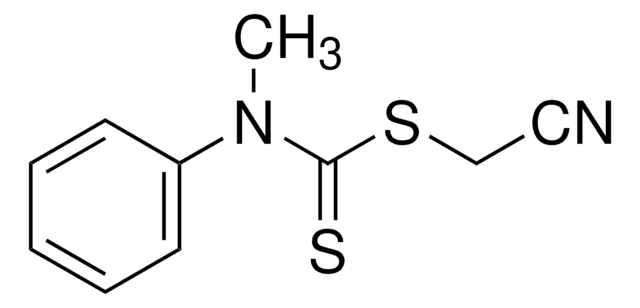723037
2-Cyano-2-propyl dodecyl trithiocarbonate
97% (HPLC)
Sinónimos:
S-(2-Cyanoprop-2-yl)-S-dodecyltrithiocarbonate
About This Item
Productos recomendados
assay
97% (HPLC)
form
liquid
refractive index
n20/D 1.535
density
0.991 g/mL at 25 °C
Storage temp.
2-8°C
SMILES string
CCCCCCCCCCCCSC(=S)SC(C)(C)C#N
InChI
1S/C17H31NS3/c1-4-5-6-7-8-9-10-11-12-13-14-20-16(19)21-17(2,3)15-18/h4-14H2,1-3H3
InChI key
QSVOWVXHKOQYIP-UHFFFAOYSA-N
General description
Application
Certificados de análisis (COA)
Busque Certificados de análisis (COA) introduciendo el número de lote del producto. Los números de lote se encuentran en la etiqueta del producto después de las palabras «Lot» o «Batch»
¿Ya tiene este producto?
Encuentre la documentación para los productos que ha comprado recientemente en la Biblioteca de documentos.
Los clientes también vieron
Artículos
RAFT polymerization uses commercial agents to control polymer properties without cytotoxic heavy metals like ATRP.
RAFT polymerization uses commercial agents to control polymer properties without cytotoxic heavy metals like ATRP.
RAFT polymerization uses commercial agents to control polymer properties without cytotoxic heavy metals like ATRP.
RAFT polymerization uses commercial agents to control polymer properties without cytotoxic heavy metals like ATRP.
Protocolos
RAFT polymerization offers precise control, enabling tailored synthesis of complex polymer structures.
RAFT polymerization offers precise control, enabling tailored synthesis of complex polymer structures.
RAFT polymerization offers precise control, enabling tailored synthesis of complex polymer structures.
RAFT polymerization offers precise control, enabling tailored synthesis of complex polymer structures.
Nuestro equipo de científicos tiene experiencia en todas las áreas de investigación: Ciencias de la vida, Ciencia de los materiales, Síntesis química, Cromatografía, Analítica y muchas otras.
Póngase en contacto con el Servicio técnico
![4-Cyano-4-[(dodecylsulfanylthiocarbonyl)sulfanyl]pentanoic acid 97% (HPLC)](/deepweb/assets/sigmaaldrich/product/structures/204/925/30ae6ca0-5b0b-4963-a061-7e5e3d1a85af/640/30ae6ca0-5b0b-4963-a061-7e5e3d1a85af.png)













![2-[[(2-Carboxyethyl)sulfanylthiocarbonyl]-sulfanyl]propanoic acid](/deepweb/assets/sigmaaldrich/product/structures/427/606/b02310e2-102e-4324-b09d-e4c0de4fab2c/640/b02310e2-102e-4324-b09d-e4c0de4fab2c.png)
